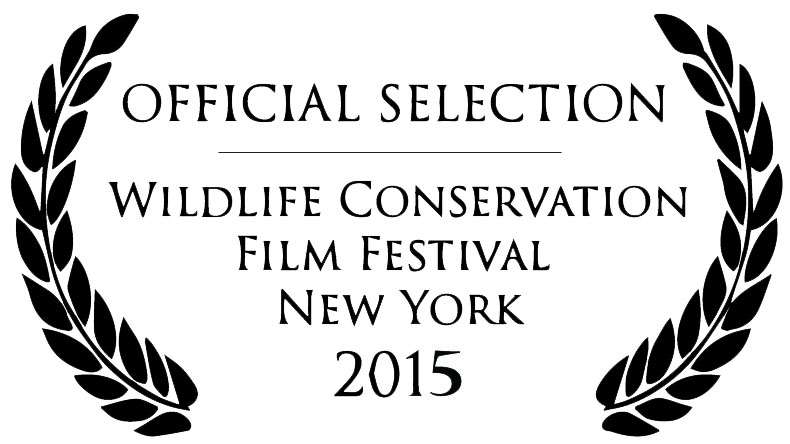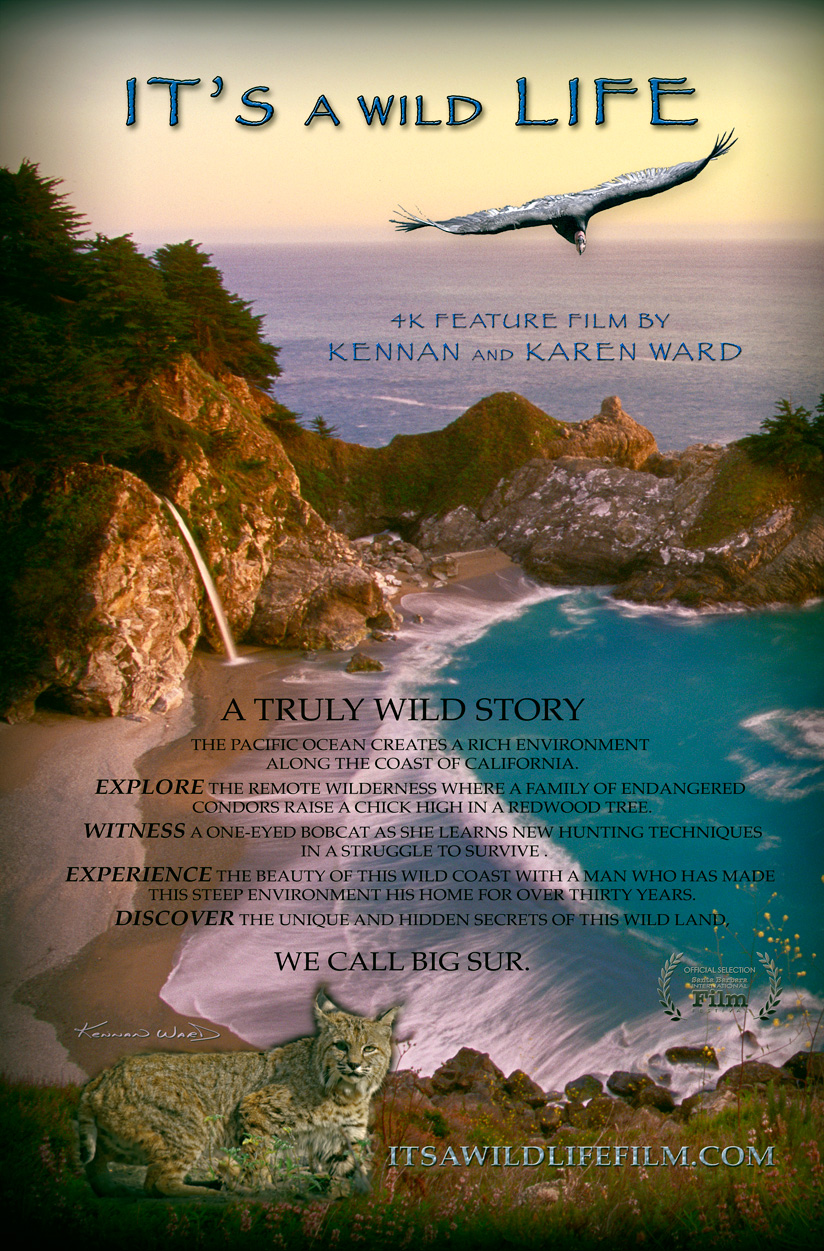Along the Northern Coast of California the Pacific ocean creates a rich environment silhouetting a World Heritage sea and landscape. The marine fog that forms along the coast allows a unique habitat for life to flourish.
We follow the main characters that are deeply influenced by this place. The human character’s name is Feynner, a long term caretaker of the land. The wildlife characters include bobcats, condors and hummingbirds.
We learn Big Sur is a land that we tried to tame, to make our own, but didn’t succeed because in some places on Earth, the physical and spiritual characteristics are too much for humans to conquer. So we learn to live by the laws of the natural world and dramatic ecosystem that we call Big Sur.
Ten Common Questions on the film “It’s A Wild Life”

- 1. How was this film made?
- Six years of filming in a wild and beautiful place captured many unique moments that make up the film. Using RED Epic and RED Dragon cameras enabled capturing extreme high speed wildlife behavior that takes place in the blink of an eye — however the playback is a twenty second extreme slow motion reveal — allowing the viewer to see details of the animal’s movement that was impossible to observe before. We spent months in the field roaming the wilds of Big Sur seeking beauty and rare moments. A team came together to tie together the story, edit the film clips and add natural sounds, music and voice overs. Last moment shots were included as new behaviors were captured.
- 2. What is so wild about Big Sur?
- We have traveled and filmed all over the world for three decades; the Arctic, the Antarctic, Africa, Alaska, Argentina, Canada, Europe, Newfoundland, Russia, Central America, South America, Australia, Papua New Guinea, New Zealand and all over the USA. After so many years seeking wildlife and wilderness we became curious of the wild areas close to home. Big Sur has some of the steepest and roughest terrain in California. Cone Peak is 5,155’ tall and is only three miles from the ocean. The jagged topography creates varied micro climates. Fog influences the plant life and here you find redwood trees along the drainages while just up the steep slopes Yucca plants grow. In spring the hilltops support wildflower filled meadows and the hilly to steep slopes are covered with Bay Laurel, oak trees and pine forests. Dry exposed slopes host chaparral, grasslands and sage. There are rocky and sandy beaches used by people, wildlife, birds and marine mammals. This region is one of the most biologically diverse we have filmed.
- 3. How did you ever get close enough to film the bobcat?
- Do you ever wonder what you saw when a group of gulls takes off from a beach? Everyone of us has a once in a lifetime observation, we think we know what occurred. . . and we wonder, what did we really see? Imagine seeing something flash out of the brush so fast that you can only guess what it may be? Our job is to show you what happened. This has taken allot of time to achieve. When filming wildlife you do not select the time or schedule, you do the research, put in the time and wait. We spent months in a photo blind, baking when the sun was out and getting really cold when it was foggy and gray. Sometimes days or weeks would pass with only tracks to be found. We wondered if we were crazy to invest so much time? Bobcats are sensitive to any disturbance or presence of humans. But, when you finally manage to film a bobcat hunting there is such a buzz of excitement that this joy stays with you. Knowing you have captured such a rare moment on film that can now be shared is the goal.
- 4. How does the land influence the ocean?
- The Santa Lucia Mountains plunge into the Pacific Ocean and this steep gradient continues out at sea. The rugged cliffs and rocks of the Big Sur coast meet the ocean water, providing a refuge for sea birds, marine mammals, abalone and fish. Offshore the prevailing northwest summer winds move the ocean surface waters and generates the upwelling of deeper colder water providing nutrients for ocean life. Three rivers and many creeks drain into the ocean providing fresh water and forest nutrients that mix with the sea. The rivers provide habitat and spawning areas for steelhead salmon. This edge of land and ocean is a margin of extreme beauty, rich diversity and activity. Three million travelers per year transit Highway One for it’s sheer beauty.
- 5. Who is Feynner?
- Feynner Arias grew up in the rainforest of Costa Rica. He gained many skills living off the land. Later he worked on ranches, on farms and in timber harvesting. He learned how to operate many kinds of equipment, expanding his technical and mechanical talent. He is an amazing problem solver and can fix many things with items he keeps on hand. He expanded his communication abilities and is bilingual. His easy nature and natural guiding talents led him into helping scientists with their projects in Costa Rica. This connection brought him to California and eventually to Big Sur, which has been his home for the last three decades.
- 6. What is going on with the Condors?
- Imagine driving down Highway One in Big Sur and finding a condor gliding along on ten foot wings. They can fly 150 miles a day seeking carrion, they soar on thermals that allow them to glide great distances without flapping their wings. Condors are an endangered species, listed in 1967. Captive breeding efforts have increased the population from 27 birds to over 400 birds, about half live in captivity and half in the wild. They are big dark birds with an average weight of twenty two pounds and can live 50 - 60 years. Adults have orange-red colored skin on their heads, chicks are dark. Condors have minimal feathers on their heads or feet, they are related to storks and vultures. They associate in social flocks. Condors have been reintroduced along the Big Sur coast and recently began to successfully nest here. They can begin breeding at six to seven years old and they mate for life. They co-parent a single chick for eighteen months. Filming at a redwood tree nest is a rare view of a condor family raising a chick in the wild. Lead poisoning remains their number one threat, as scavengers they consume lead bullet fragments when they feed upon game carcasses or waste piles. This can be resolved by switching from lead ammunition over to stainless steel or copper bullets.
- 7. What’s the story behind the smallest and largest extremes?
- Have you experienced such a calm that you can hear a huge breath from the sea? When you turn your head to look all you find is a fog rising from the ocean. You wonder about whales migrating, is this the time of year they are traveling south? Or north? All of life is interconnected. We discuss hummingbird’s and the importance of their role in plant pollination in this area; and we explore the redwood tree’s. In Big Sur the redwoods are living near the southern most boundary of their habitat, the landscape becomes too dry to support them further south. Part of what unites these two extreme elements is that often the hummingbird builds it’s nest in the redwoods branches. So one of the largest living organisms the redwood tree, provides shelter and a home for one of the tiniest of living birds.
- 8. What is the significance of the huge flocks of Sooty Shearwaters?
- The Sooty Shearwaters migrate all the way from their nesting grounds in New Zealand to three prime feeding areas. These areas are rich in nutrients from oceanic upwelling. Sooty Shearwaters aggregate off the coast of Japan, the coast of Chile and off the central California coast. Huge flocks of Sooty Shearwaters throng together in these feeding frenzy’s and you question how can such a concentration of birds move together so crowded in flight without numerous collisions? Schools of anchovies attract the Sooty Shearwaters who feed upon them in flocks numbering up to a hundred thousand. Astonishingly as many birds can be below the water swimming and feeding as you can view above the water. The upwelling off the California coast feeds seabirds, fish, marine mammals and whales. This phenomenon brings life to the Pacific Ocean and it’s inhabitants. As filmmakers this shows the connection between Big Sur and the rest of the globe in this example of migration.
- 9. What about the hazards of ticks and poison oak?
- Well, when you see the scene of Feynner crawling into a patch of poison oak to track a bobcat, the camera and Kennan are in there too! Poison Oak is part of the landscape and a risk to all who visit. We get the itchy burning rash, but have build up some tolerance. The best route is to avoid it as best as possible, but at times you must immerse into or through it to follow wildlife. Afterward such exposure we wash everything: boots, packs, tripods! Ticks seem to emerge after the first rains and they are hungry. We tuck our pant legs into our sox so they cannot crawl up your legs and we watch for dark spots on clothing that can be approaching ticks. The worst I have ever seen was a tick that had engorged to the size of a golf ball hanging off of a deer. I first thought it was a tumor, I did not know a tick could attain that size!
- 10. What is next?
- We have explored and photographed so many beautiful areas, that now we can enjoy going back to all our favorite places with the addition of the Red Dragon cinema camera and record through new eyes all the fantastic gifts of nature.
© 2015 It’s a Wild Life Film













